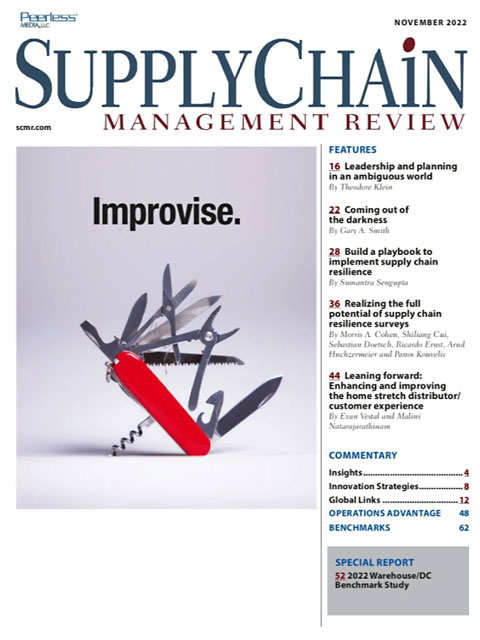Sorry, but your login has failed. Please recheck your login information and resubmit. If your subscription has expired, renew here.
November 2022
Are you resilient? It’s not an idle question. If there’s one word that I’ve heard at every supply chain event I’ve attended this year, its resilience. It is, of course, in response to the last few years in supply chain management. I think its fair to say that supply chains have been knocked to the canvas more times than Rocky. What has become clear as we do our post-pandemic reviews is that the firms that demonstrated the ability to get up off the canvas and keep punching were those that invested in resiliency before the pandemic—even if they didn’t use that term. Browse this issue archive.Need Help? Contact customer service 847-559-7581 More options
Lately, there has been no shortage of supply chain disruptions. Similarly, there’s been no shortage of efforts by supply chain executives to develop strategies to accommodate and overcome these disruptions and increase supply chain resilience. Unfortunately, the disruptions still have the upper hand.
Efforts to develop supply chain strategies for resilience have typically started with surveys to assess what happened and how companies have responded. And this newly collected information typically led to actionable strategies that coped with disruptions. But this time around, effective strategies haven’t been quite so easy to develop. Clearly, there is a need to modify how surveys are designed in the first place to extend their value to supply chain managers. Fortunately, doing that isn’t so difficult.
The unit of analysis gap These surveys usually focus on supply chain resilience based on all of the companies in the sample as the units of analysis. A typical observation would be “x% of all companies regionalize their supply chain.” In some survey reports, industry-specific differences are analyzed. This can lead to interesting insights. However, companies operate within idiosyncratic environments that actually create a need for more specific and differentiated analysis than previously available.

This complete article is available to subscribers only.
Log in now for full access or start your PLUS+ subscription for instant access.
SC
MR
Sorry, but your login has failed. Please recheck your login information and resubmit. If your subscription has expired, renew here.
November 2022
Are you resilient? It’s not an idle question. If there’s one word that I’ve heard at every supply chain event I’ve attended this year, its resilience. It is, of course, in response to the last few years in… Browse this issue archive. Access your online digital edition. Download a PDF file of the November 2022 issue.Lately, there has been no shortage of supply chain disruptions. Similarly, there’s been no shortage of efforts by supply chain executives to develop strategies to accommodate and overcome these disruptions and increase supply chain resilience. Unfortunately, the disruptions still have the upper hand.
Efforts to develop supply chain strategies for resilience have typically started with surveys to assess what happened and how companies have responded. And this newly collected information typically led to actionable strategies that coped with disruptions. But this time around, effective strategies haven’t been quite so easy to develop. Clearly, there is a need to modify how surveys are designed in the first place to extend their value to supply chain managers. Fortunately, doing that isn’t so difficult.
The unit of analysis gap These surveys usually focus on supply chain resilience based on all of the companies in the sample as the units of analysis. A typical observation would be “x% of all companies regionalize their supply chain.” In some survey reports, industry-specific differences are analyzed. This can lead to interesting insights. However, companies operate within idiosyncratic environments that actually create a need for more specific and differentiated analysis than previously available.
SC
MR


Latest Supply Chain News
- How CPG brands can deliver on supplier diversity promises
- How S&OP provides the answer to in-demand products
- AI, virtual reality is bringing experiential learning into the modern age
- Humanoid robots’ place in an intralogistics smart robot strategy
- Tips for CIOs to overcome technology talent acquisition troubles
- More News
Latest Podcast

 Explore
Explore
Business Management News
- How CPG brands can deliver on supplier diversity promises
- How S&OP provides the answer to in-demand products
- AI, virtual reality is bringing experiential learning into the modern age
- Tips for CIOs to overcome technology talent acquisition troubles
- There is still work to do to achieve supply chain stability
- Blooming success: The vital role of S&OE in nurturing global supply chains
- More Business Management
Latest Business Management Resources

Subscribe

Supply Chain Management Review delivers the best industry content.

Editors’ Picks






